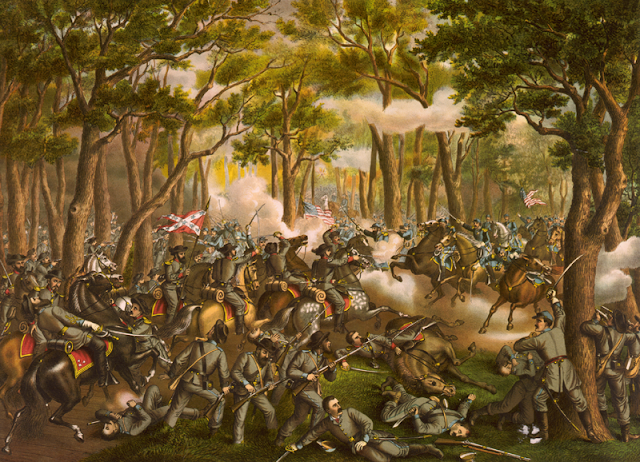May 5, 1864: Grant's Army of the Potomac and Lee's Army of Northern Virginia face off against each other in the Battle of the Wilderness
By the end of 1863, President Abraham Lincoln was desperate
for a general who could defeat Confederate General Robert E. Lee’s Army of
Northern Virginia. In March 1864, he decided on the victor of Shiloh and
Vicksburg, Ulysses S. Grant. Grant was different from any of Lincoln’s previous
generals. He was dogged, methodical, and had a plan on how to defeat Lee.
Instead of attacking the Confederate capital of Richmond, he would take the
fight directly to Lee’s army. In April, the newly promoted, Lieutenant General Grant
rode to down to link up with the Army of the Potomac in Virginia. The former
commander of the army, George Gordon Meade nervously awaited his replacement’s
arrival. When Grant arrived, he decided that Meade would keep command of the
Army of the Potomac with his direction. He further assigned, his friend, William
Tecumseh Sherman his old command of armies in the Western Theatre of the war.
He gave the command of the Union cavalry to Philip H. Sheridan, a commander known
for his short stature and tenacity. He devised a coordinated strategy for all
three armies to engage in order to bring the war to swift, decisive conclusion.
Sheridan’s cavalry was tasked with clearing the Confederates out of the Shenandoah
Valley. Sherman’s army would move southeast from Tennessee into Georgia to attack
Joseph E. Johnston’s army. For the Army of the Potomac, they were tasked with directly
attacking Lee’s Army of Northern Virginia. In May, Grant’s army met Lee’s army,
in the Battle of Wilderness.
On May 4, the Army of the Potomac crossed the Rapidan River and
converged on the edge of the Wilderness in Spotsylvania County. Lee’s army was already
spread throughout the Wilderness in anticipation of Grant’s attack. Lee was
outnumbered, but knew Grant would have to venture in the thickly wooded
Wilderness to fight him. Battle commenced early on the 5th near the
Orange Turnpike. Further toward the South, a section of both armies engaged on
the Orange Plank Road. By the evening, both skirmished had ended in stalemate.
The following day, Grant’s forces resumed the attack, much to the same result.
After the day’s battle had ended, Lee decided to dig in to ward off Grant’s
attacks. Instead of attacking directly, Grant decided to shift southward to Spotsylvania
Court House in order to turn Lee’s flank. Both armies would engage there over
the following weeks.
The Battle of the Wilderness proved to be a pyrrhic victory
for the South, and a strategic coup for the North. While the causalities were
not unheard of, the manner in which they were inflicted was unseemly. The
battle sparked several small forest fires in the heavily wooded area. The
soldiers who were not luckily to be killed instantly, were subjected to death
from smoke inhalation or ever burning to death in the conflagration. Grant was
derided for wasting Union lives; but Grant was no butcher. He understood the
costs it would take to destroy Lee’s army. The battle cost Lee’s army many causalities
that he could not replace. The battle while it was truly a stalemate, it marked
the beginning of the end of Lee’s Army of Northern Virginia, and the Civil War itself.




Comments
Post a Comment